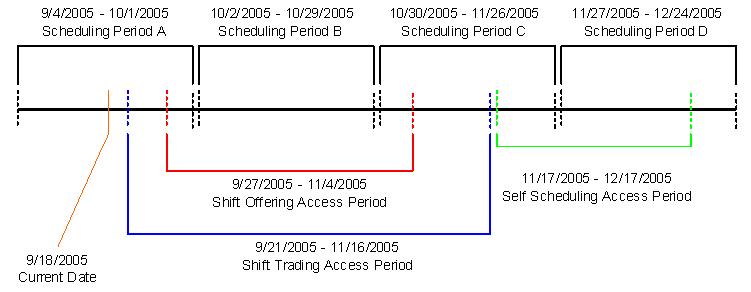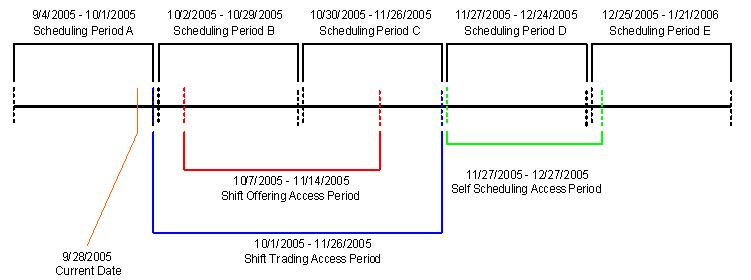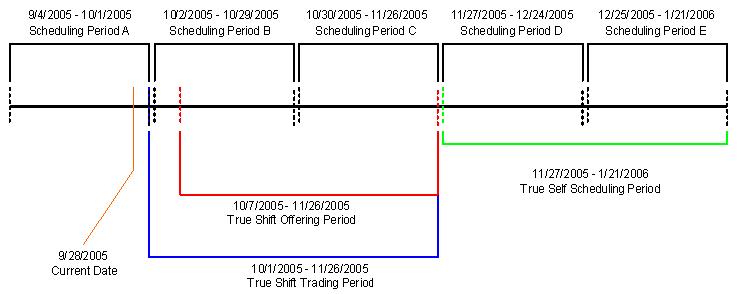Self Scheduling Access Sequence
In order to be accessible for self scheduling, the first date of a scheduling period must fall within the self scheduling access period, which starts on or after the Self Schedule Begin Advance Days and ends on or before the Self Schedule End Advance Days values. If it falls in this window, the whole scheduling period is accessible for self scheduling.
When the first date of the scheduling period no longer falls between the Self Schedule Begin Advance Days and Self Schedule End Advance Days, the scheduling period is no longer accessible for self scheduling, even though some days in the schedule period may still fall in the access window.
Accessibility is the same for shift trading/offering, with the difference that the window is included even if the dates are not contained in a schedule period that has a begin date in the window.
When using both the Self-Scheduling and Shift Trading/Offering features, below is the sequence of access time frames. The access periods are calculated from the current date.
-
Self scheduling time frame opens, based on the Self Schedule Begin Advance Days.
-
Employees can self schedule, using the Open Self Schedule screen in the employee record. If self schedule groups are used, employees can only access self scheduling during the times set up for their group on the Self Schedule Group Order Table.
-
Self scheduling time frame closes, based on the Self Schedule End Advance Days. The manager review time frame begins on this same date.
Note:
If Organization Unit Indicator SS Solution Standard 7 is set to 'N', employees cannot view pending schedules during the manager review period.
-
The schedule is published.
-
The manager reviews time frame ends, based on the Self Schedule Review Period End Advance Days. Employees can view all self scheduling information.
-
The time frame opens for employees to transfer and/or offer shifts. Transfers and offers can occur in the same time frame.
-
Employees can trade shifts, starting with date that is the number of days in advance of the shift date indicated by the Shift Trade Begin Advance Days.
-
Employees can offer shifts, starting with the date that is the number of days in advance of the shift date indicated by the Shift Offer Begin Advance Days. Employees can accept offered shifts up to this same date.
-
-
The time frame closes for employees to transfer and/or offer shifts.
-
Employees cannot trade shifts, starting from the number of days before the shift date indicated in the Shift Trade End Advance Days field.
-
Employees cannot offer shifts, starting from the number of days before the shift date indicated in the Shift Offer End Advance Days field.
Note:
For more information on setting up the screens for self scheduling, see .
-
The following are examples of the access time frames for self scheduling, trading, and offering of schedules.
EXAMPLE 1: The diagram below represents the following setup:
|
Self Scheduling |
Begin Advance Days = 90 End Advance Days = 60 |
|
Shift Trading |
Begin Advance Days = 59 End Advance Days = 3 |
|
Shift Offering |
Begin Advance Days = 47 End Advance Days = 9 |
|
Current Date |
09/18/05 |
|
Schedule Periods |
09/04/05 - 10/01/05 10/02/05 - 10/29/05 10/30/05 - 11/26/05 11/27/05 - 12/24/05 |

In above scenario, when the Current Date is 9/18/05, the Shift Trading Access Period will be from 9/21/05 until 11/16/05. The Shift Offering Access Period will occur from 9/27/05 through 11/4/05. The Self Scheduling Access Period will be from 11/17/05 until 12/17/05. However, the below diagram displays when these actions are valid due to Schedule Period occurrences.

The Original Begin Dates for Trading and Offering will hold true, but the New End Dates will be extended to the end of the Scheduling Period for which the Original End Dates existed in. So instead of Trading ending on 11/16/05 and Offering Ending on 11/4/05, both actions can be performed on Published schedules as far into the future as 11/26/05. The Self Scheduling Period Begin Date actually moved from 11/17/05 to 11/27/05 because the dates prior to 11/27/05 existed in a Schedule Period for which the Begin Date did not exist within the Self Scheduling Access Period. However, the End Date for Self Scheduling moved from 12/17/05 to 12/24/05 since the Begin Date of the Schedule Period from 11/27/05 through 12/24/05 did fall within the Self Scheduling Access Period.
EXAMPLE 2: In this example, the only change will be that the Current Date will now be
9/28/05 instead of 9/18/05 to show how the Periods shift when the date changes.
Here is the representation of the Access Periods for a Current Date of 9/28/05

Below would again represent the true time frame these actions can be performed in.

As the time line displays, ten days after Example 1 an employee now has the ability to Self Schedule into Scheduling Period E since the Begin Date of Schedule Period E now falls within the Self Scheduling Access Period. The key to understanding how the Self Scheduling module operates is within understanding this moving window concept.
Once the Access periods have been defined, a Selection Style may also be assigned to each of the 3 periods. The Selection Style is going to be an Edit Validation type Selection Style. The next step is to set up the Organization Unit indicators that are associated with Self Scheduling.
|
The following related topics are available: |